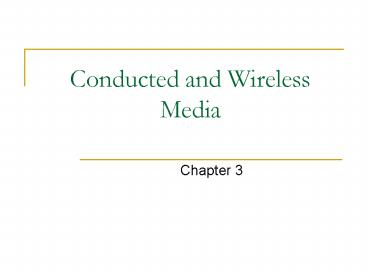Conducted and Wireless Media - PowerPoint PPT Presentation
1 / 22
Title:
Conducted and Wireless Media
Description:
Identify and describe the characteristics, advantages, disadvantages, and ... GEO - Geosynchronous Orbit. HEO Highly Elliptical Orbit ... – PowerPoint PPT presentation
Number of Views:112
Avg rating:3.0/5.0
Title: Conducted and Wireless Media
1
Conducted and Wireless Media
- Chapter 3
2
Learning Objectives
- Identify and describe the characteristics,
advantages, disadvantages, and applications of
guided or conducted media - Identify and describe the characteristics,
advantages, disadvantages, and applications of
radiated or wireless media - Identify media selection criteria
3
Communications Media
- Guided (physical or conducted)
- Twisted-Pair
- Coaxial cable
- Fiber optic cable
- Radiated (or wireless)
- Terrestrial microwave
- Satellite microwave
- Cellular telephone systems
- Infrared transmission
- Broadband wireless distribution services
- Bluetooth
- Wireless LAN systems
- Zig-bee short-range transmissions
4
Twisted Pair wire
- Two or more pairs of single conductor copper
wires that have been twisted around each other. - Oldest, simplest, most common
- Types include category 1-5, 5e, 6-7
- Unshielded twister pair (UTP) shielded twisted
pair (STP)
5
Twisted Pair Wire (continued)
6
Coaxial cable
- A single wire wrapped in a foam insulation
surrounded by a braided metal shield, then
covered in a plastic jacket. Cable can be thick
or thin. - Baseband coaxial technology
- Broadband coaxial technology
7
Chapter 5 Communications Media, Servers, and
Clients 7
8
Fiber optic cable
- A thin glass cable approximately a little thicker
than a human hair surrounded by a plastic coating
and packaged into an insulated cable. - A photo diode or laser generates pulses of light
which travel down the fiber optic cable and are
received by a photo receptor.
9
Chapter 5 Communications Media, Servers, and
Clients 9
10
Wireless media
- Radio, satellite transmissions, and infrared
light are all different forms of electromagnetic
waves that are used to transmit data. - Each source occupies a different set of
frequencies. - FCC assigns frequencies for each application
occasionally auctions unused frequencies.
11
Wireless Media (continued)
12
Terrestrial Microwave
- Land-based, line-of-sight transmission
- Approximately 15-30 miles maximum between towers
- Transmits data at hundreds of millions of bits
per second - Popular with telephone companies and business to
business transmissions
13
Satellite Microwave
- Similar to terrestrial microwave except the
signal travels from a ground station on earth to
a satellite and back to another ground station. - Satellites can be classified by how far out into
orbit each one is (LEO, MEO, GEO, and HEO).
14
Satellites
- LEO - Low Earth Orbit
- MEO - Middle Earth Orbit
- GEO - Geosynchronous Orbit
- HEO Highly Elliptical Orbit
15
Cellular Telephone
- Wireless telephone service, such as cellular
telephone, cell phone, and PCS. - To support multiple users in a metropolitan area
(market), the market is broken into cells. - Each cell has its own transmission tower and set
of assignable channels.
16
Infrared
- Special transmissions that use a focused ray of
light in the infrared frequency range. - Very common with remote control devices, but can
also be used for device-to-device transfers, such
as PDA to computer.
17
Wireless Application Protocol (WAP)
- WAP is a set of protocols that allows wireless
devices such as cell phones, PDAs, and two-way
radios to access the Internet - WAP is designed to work with small screens and
with limited interactive controls - WAP incorporates Wireless Markup Language (WML),
which is used to specify the format and
presentation of text on the screen
18
Wireless Application Protocol (WAP) (continued)
- WAP may be used for applications such as
- Travel directions
- Sports scores
- Online address books
- Traffic alerts
- Banking and news
- Possible shortcomings include low speeds,
security, and very small user interface
19
Broadband wireless systems
- Delivers Internet services into homes and
businesses. - Designed to bypass the local loop telephone line.
- Transmits voice, data and video over high
frequency radio signals.
20
Bluetooth
- Bluetooth is a Radio Frequency specification for
short-range, point-to-multipoint voice and data
transfer. - Bluetooth can transmit through solid, non-metal
objects. - Its typical link range is from 10 cm to 10 m, but
can be extended to 100 m by increasing the power. - Bluetooth will enable users to connect to a wide
range of computing and telecommunication devices
without the need of connecting cables. - Typical uses include phones and pagers, modems,
LAN access devices, headsets, notebooks, desktop
computers, and PDAs.
21
Wireless Local Area Networks (IEEE 802.11)
- This technology transmits data between
workstations and local area networks using
high-speed radio frequencies - Current technologies allow up to 54 Mbps
(theoretical) data transfer at distances up to
hundreds of feet - Three popular standards IEEE 802.11b, a, g
- More on this in Chapter Seven (LANs)
22
Media selection criteria
- Cost
- Initial cost, ROI, maintenance/support cost
- Speed
- Data transfer speed, propagation speed
- Distance and expandability
- Environment
- Security
- Wiretap possible? Need encryption?

